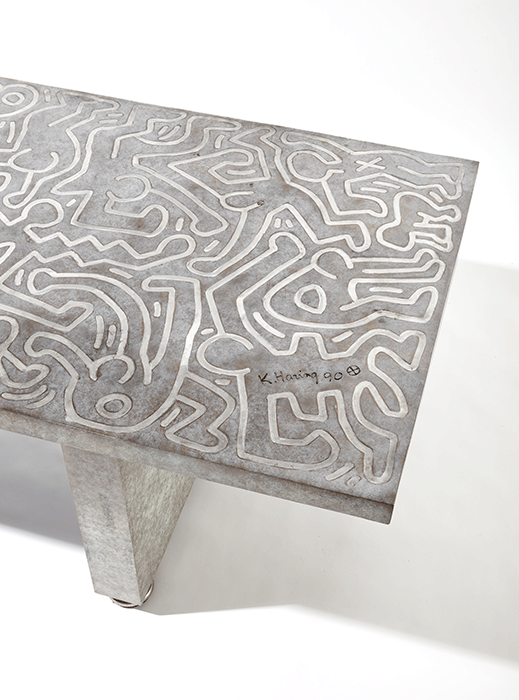A canonical figure of 20th century art history, Keith Haring crafted a unique graffiti-inspired iconography that bridged so-called “high” and “low” forms of art to engage with themes ranging from activism to pop culture. Maintaining a public-oriented approach rooted in universally digestible forms, Haring expanded his practice to include diverse media such as murals, clothing, and—in the last year of his all-too-brief career—furniture. Executed in 1990 just months before his death, this writing table expanded upon his long-running conceptual concern of making highly legible and experiential work to new ends.
"There is within all forms a basic structure, an indication of the entire object with a minimum of lines that becomes a symbol. This is common to all languages, all people, all times."
—Keith Haring
Created at the encouragement of his friend, collector, and fellow artist, Sam Havadtoy, Haring’s foray into furniture marked a period of prolific artistic output at the end of his life. He produced several pieces within the span of a few months, including an edition of writing desks, coffee tables, paneled screens, fireplaces, and altarpieces. “The whole project came out of when I was decorating [Haring’s] house in December 1989,” Havadtoy elucidated. “In his living room was an old brick fireplace which he hated, so I had it plastered over. The plaster was wet and I suggested that he draw into it. He thought it was a cool idea. It was as if the plaster were a three-dimensional textured canvas. He loved drawing in the plaster, and got very excited about the new medium. When he finished, it was very beautiful.”i
Haring’s work on furniture also coincided with another significant material discovery: bronze. Utilizing the method of plaster drawing that he had developed to inscribe the fireplace, Haring approached this new medium with zeal, wielding his knife like a brush to create a nine-piece bronze furniture set bearing his signature visual idiom. Seminal in terms of medium, subject, and execution, the present writing table is inlaid with his hand-drawn designs of dynamic bodies, finished with a unique white patina that Havadtoy specifically requested to differentiate the piece from the rest of the edition.

Haring’s distinctive figures that fill the table—their delineated forms span its top—seem to pulse with movement and reveal the depth of his commitment to an aesthetic vernacular premised on identification and emotional affect. “The images came directly from his head. He placed the knife in the clay and carved a continuous running line, a quarter-of-an-inch deep groove, which wound like a swollen stream during the spring thaw,” Havadtoy recalled. “He never stopped to rethink the line; he never edited himself and never made corrections. The lines he carved in the clay were seamless, flawless.”ii An expression of his radical readability, this writing table demonstrates the possibilities offered by the artist’s distinctive approach. Years earlier, Haring had written that he was “intrigued with the shapes people choose as their symbols to create a language. There is within all forms a basic structure, an indication of the entire object with a minimum of lines that becomes a symbol. This is common to all languages, all people, all times.”iii And so, although these forms appear throughout Haring’s oeuvre, their placement on the present work can be understood as an extension of his wish to make art present in all moments of life—a desire which strives for the experiential engagement of its viewer or user.
